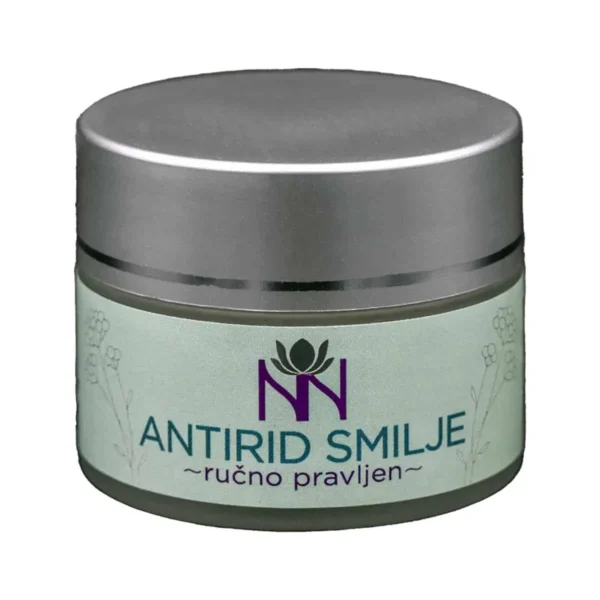Eye Cream – Everything You Need to Know About Eye Area Skincare

Have you noticed the first fine lines when you smile? Or perhaps “bags” under your eyes that make you look tired regardless of how much sleep you’ve gotten? If you recognize yourself in these situations, it’s time to meet your new best friend – eye cream.
The eye area is the first to betray our age, but it’s also the first that can be transformed with proper care. Eye cream isn’t just another product in your beauty routine – it’s a specialized cream that can dramatically change how you look and feel.
What is Eye Cream Actually?
Eye cream is a specialized cream designed exclusively for caring for the skin around the eyes. This is NOT a face cream that can coincidentally be used around the eyes. Eye cream is a precise product formulated to respond to the unique needs of the most delicate area of our face.
The skin around the eyes is 10 times thinner than the skin on the rest of the face. Imagine the difference between thin silk and thick cotton – that’s how drastic the difference is. Due to this thinness, this area:
- Shows signs of aging first
- Is most easily irritated
- Has the least natural oils to protect it
- Is constantly in motion (blinking, smiling, squinting)
- Is most exposed to UV radiation
Because of all these factors, eye creams contain gentler concentrations of active ingredients that are otherwise found in skincare cosmetics, but are formulated to be especially effective for the skin of this delicate region.
Helichrysum Eye Cream
Contains beeswax, almond, calendula, olive, and sunflower oils Enriched with Helichrysum flower extract and vitamin E Fragrance-free formulation Intensely nourishes and hydrates the delicate skin around the eyes Reduces the depth of existing wrinkles and slows the formation of new ones Does not cause eye irritation Handcrafted in small batches
Why is Eye Cream Irreplaceable in Your Routine?
Prevention is where you start
The first rule for eye cream is to start before problems become visible. The skin around the eyes begins losing elasticity already in the twenties, although you might not notice it immediately.
We use eye cream even before the first signs of aging and fatigue in the eye area appear because it:
- Protects from external influences – UV radiation, air pollution, blue light from screens
- Strengthens thin skin – helps it regenerate faster
- Maintains hydration – prevents dehydration that leads to earlier wrinkles
Correction of Existing Problems
If you already have fine lines, dark circles, or puffiness around your eyes, eye cream can significantly improve the situation:
- Reduces wrinkle depth – active ingredients “fill” wrinkles from within
- Evens skin color when dark circles appear – improves circulation and skin tone
- Reduces puffiness – ingredients like caffeine in eye creams can drain excess fluid
- Tightens skin – for example, peptides in eye creams stimulate collagen production
Improvement of Texture and Tone
Regular use of eye cream makes the skin around the eyes:
- Smooth to the touch
- Firmer and more elastic
- Even-toned
- Naturally radiant
How Does Eye Cream Differ from Other Products?
Many women make the mistake of using regular moisturizing creams for the eye area, not understanding that they can do more harm than good.
Key Differences of Eye Cream:
Concentration of Active Ingredients
- Eye cream: 5-15% active components adapted to delicate skin
- Face creams: 15-30% active ingredients that can be too aggressive
Molecular Size
- Eye cream uses smaller molecules that penetrate thin skin more easily
- Texture is lighter and absorbs faster
pH Value
- Eye creams have pH closer to the natural pH of the eye (7.0-7.4)
- Face creams can have pH that irritates the sensitive eye area
Specialized Ingredients
- Caffeine for reducing puffiness
- Vitamin K for dark circles
- Peptides for “ironing out” wrinkles
- Plant-based retinol alternatives that may be too aggressive for this region
Testing
- Eye creams undergo ophthalmological testing
- They’re safe for contact with eyes and for people wearing contact lenses

Who is Eye Cream For and When to Start?
For Women in Their Twenties (22-28 years)
Signs it’s time for eye cream:
- You’ve noticed fine lines when you smile
- Skin around eyes looks drier
- You frequently work at a computer (blue light)
- You wear sunglasses more often due to “squinting”
Recommended approach: Gentle eye cream with hyaluronic acid and antioxidants.
For Women in Their Thirties (28-38 years)
Time for more serious preparations if:
- Wrinkles are visible even without smiling
- First dark circles have appeared
- Skin around eyes visibly loses elasticity
Recommended approach: Active formulations with peptides and gentle retinol derivatives.
For Women in Their Forties and Beyond (38+ years)
Strong formulations are needed because:
- Wrinkles around eyes are deeper and now permanent
- There’s significant skin sagging
- Dark circles are visible every day
Recommended approach: Intensive eye cream with a combination of multiple active ingredients.
How to Apply Eye Cream Properly?
Proper application of eye cream is the key to success. An error in facial skincare routine can nullify all the benefits of even the best product.
Step-by-Step Technique:
- Hand preparation – Wash your hands and gently dry them. Apply eye cream with your ring finger, which applies the least pressure.
- Amount – Size of a grain of rice per eye. This seems small, but the skin around the eyes cannot absorb more.
- Application zone – Start from the inner corner of the eye, under the eye, to the outer corner, then up to the eyebrow. DO NOT put directly on the movable part of the eyelid.
- Technique – Gentle tapping, NEVER rubbing. Start from the inner corner and go outward.
- Pressure – So light that you barely touch the skin. Imagine tapping a soap bubble that could burst.
- Finish – Wait for it to be completely absorbed before applying the next product.
IMPORTANT: Never pull or stretch the skin during application. This area is already under stress from constant movement and facial expressions.
When is Eye Cream Applied in the Skincare Routine?
Morning Routine:
- Face cleansing
- Toner
- EYE CREAM
- Face serum (don’t apply over eye cream)
- Moisturizing face cream (don’t apply over eye cream)
- SPF
Evening Routine:
- Makeup removal
- Face cleansing
- Toner
- EYE CREAM
- Face serum (don’t apply over eye cream)
- Night cream (don’t apply over eye cream)
Key rule: Eye cream is always applied BEFORE face creams because it has a lighter texture and must reach the skin first.
When NOT to Apply Eye Cream?
Situations to avoid:
Medical Contraindications:
- Acute eye infection
- Allergic reaction
- Damaged skin (cuts, eczema, burns)
- Directly after aesthetic treatments around the eyes
Situational Factors:
- When using retinoids in the same area
- If you’re pregnant and the eye cream contains ingredients not safe for pregnant women
Important Notes:
- Stop using any eye cream if you notice skin irritation
- Don’t use multiple layers of different eye creams simultaneously
- Avoid direct application before sun exposure without SPF
- Eye cream shouldn’t be applied before waterproof mascara as it can nullify its effect
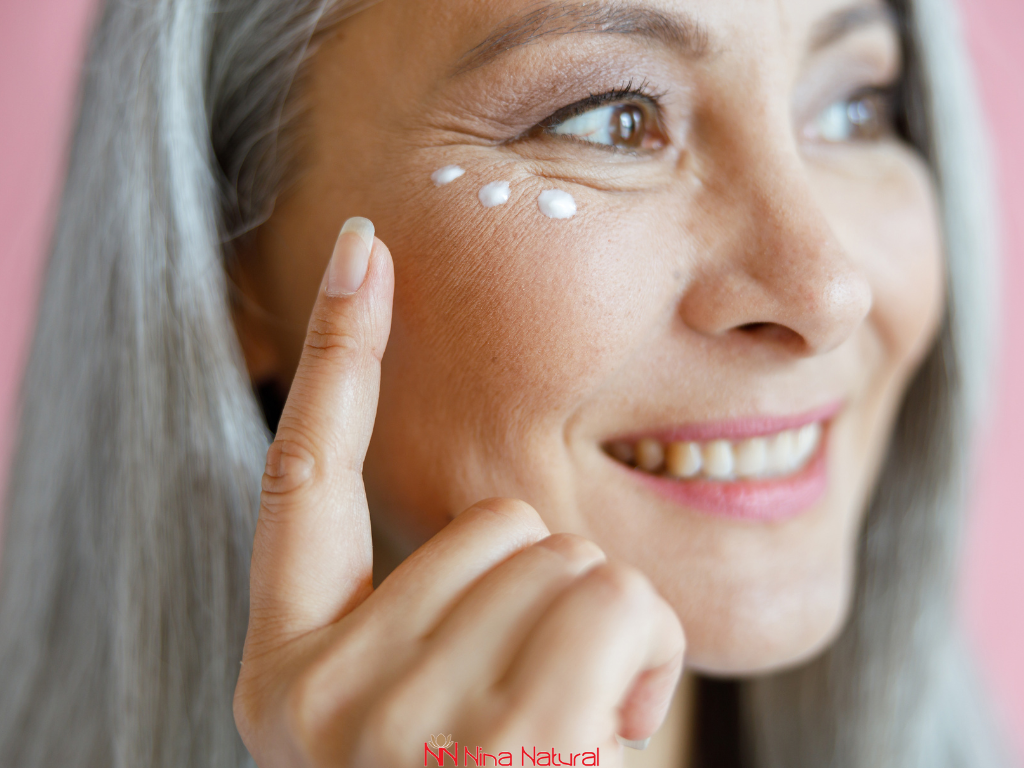
Most Common Mistakes Women Make
Mistake #1: Using Too Much Product
Problem: “If a little is good, then more is better” Reality: Too much eye cream can clog fine pores around the eyes, plus concentrated active ingredients can irritate delicate skin. Solution: Stick to the recommended amount!
Mistake #2: Aggressive Rubbing
Problem: Treating eye area skin the same as applying body cream Reality: Aggressive rubbing won’t help delicate skin absorb ingredients better Solution: Gentle tapping with the ring finger
Mistake #3: Applying Too Close to the Eye
Problem: Putting eye cream directly on the movable part of the eyelid Reality: Can lead to irritation and product getting into the eye Solution: Stay within the orbital bone area
Mistake #4: Using Wrong Order
Problem: Applying eye cream over face cream Reality: Cream blocks absorption of active ingredients carried by retinol Solution: Always eye cream first, then other products
Mistake #5: Inconsistency
Problem: Using “when I remember” Reality: Eye cream will show its effect only with regular use – minimum 3 months Solution: Incorporate into daily routine like brushing teeth
Myths We Love
The 90-Second Rule
This is a rule that can dramatically improve your eye cream’s effectiveness, and most women don’t know it.
What it means: After applying eye cream, wait a full 90 seconds before applying the next product.
Why it’s important:
- Optimal absorption – Active ingredients have time to penetrate deeper skin layers before the next product creates a barrier
- Preventing “mixing” – When eye cream mixes with other products, the concentration of active ingredients decreases
- Maximum effectiveness – Each ingredient can do its job without interference from other products
- Reduced irritation – Skin has time to adjust to one product before introducing the next
Practical tip: Use these 90 seconds to clean makeup brushes, make coffee, or simply take a deep breath – it’s your moment for yourself.
Storing Eye Cream in the Refrigerator
Is it necessary? Short answer: Not essential, but can have significant benefits for certain types of eye creams.
Advantages of cooling:
Extended stability of active ingredients:
- Vitamin C stays potent longer
- Peptides don’t degrade as quickly
- Natural ingredients without preservatives last longer
Additional therapeutic effects:
- Cold reduces eye puffiness
- Improves circulation
- Gives feeling of freshness and awakening
- Helps with allergic reactions
Sensory experience:
- Refreshing feeling
- Can reduce redness
- Helps with eye fatigue
Which eye cream can be better when cold:
Must refrigerate:
- Eye cream with vitamin C
- Products with caffeine
- Natural formulations without preservatives
- Eye cream in glass packaging
Can be refrigerated:
- Eye cream with peptides
- Gel-based eye creams
- Eye creams for morning use
Temperature: 4-8°C (regular refrigerator). NEVER freezer!
Frequency of Eye Cream Use
For Beginners (first-time eye cream users):
- First 2 weeks: Every day, evening
- Next 2 weeks: Every day evening, every other day morning and evening
- After a month: Every day, morning and evening
For Experienced Users:
- Standard regimen: Every day, morning and evening
- Intensive treatment: Morning and evening eye cream different formulas
Special Situations:
- Summer period: Focus on morning application with SPF
- Winter period: Increase frequency (try to apply eye cream twice daily) due to dry air
Important: Listen to your skin. Irritation is a sign to slow down, and improvement is a sign you can increase frequency.
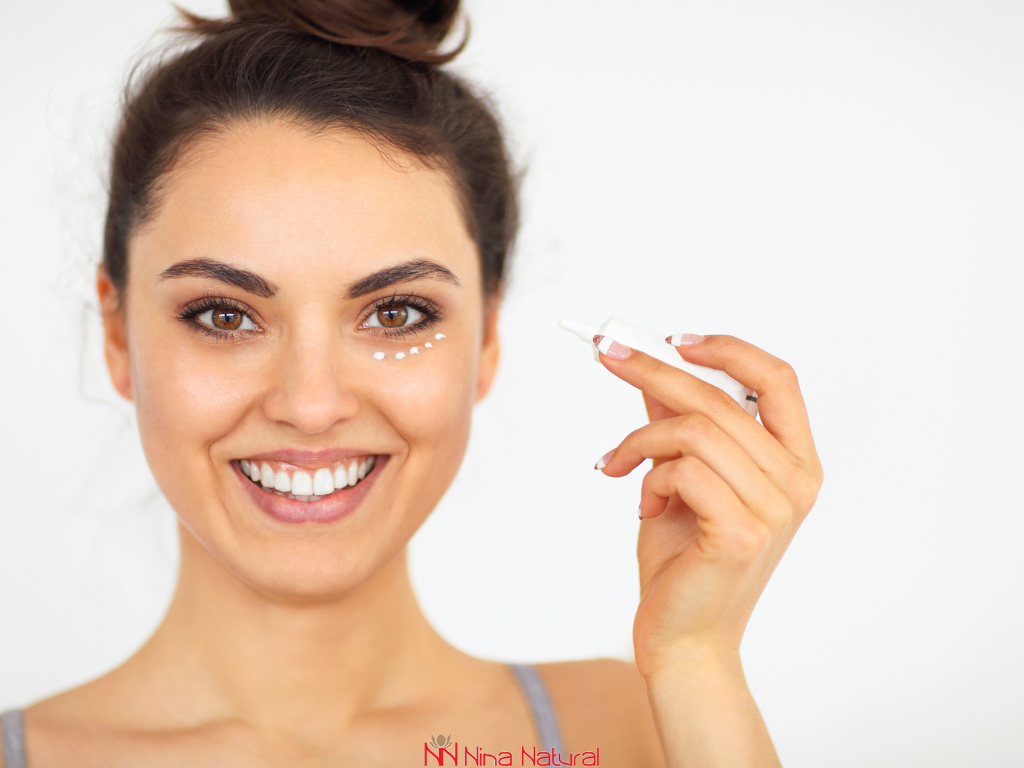
Required Amount of Eye Cream
Precise Measurements:
For one eye: amount equivalent to a grain of rice
Practical Dosing Tips:
If too much:
- Product doesn’t absorb completely
- You feel stickiness
- Irritation may occur
- You’re wasting money
If too little:
- Not enough active ingredients for effect
- Uneven coverage
- Slower results
Perfect amount:
- Covers entire eye area
- Absorbs in 60-90 seconds
- Doesn’t leave sticky feeling
- Skin looks hydrated
Test for proper amount: After 90 seconds from application, gently touch the skin around your eyes. It should be hydrated but not sticky.
Types of Eye Cream Packaging
Tubes
Advantages:
- Economical
- Easy to carry and travel
- Good quantity control
Disadvantages:
- Harder to clean the tip
- Air enters through opening
Pumps
Advantages:
- Precise dosing
- Protected from air
- Maximum protection from oxidation
- Every drop of product is used
- Long-lasting formulation
Disadvantages:
- More expensive
- Mechanism can break
- Harder to recycle
- Often not transparent (can’t see how much is left)
Glass Bottles with Dropper
Advantages:
- Very precise dosing
- Good protection from light (dark glass)
Disadvantages:
- Risk of breaking
- Contamination through dropper
- Impractical for travel
Jars
Advantages:
- No risk of squeezing out excess preparation
- Glass packaging preserves ingredients
Disadvantages:
- Risk of breaking
- Contamination because we touch contents with hands
- Impractical for travel
Types of Eye Cream by Active Ingredients
Retinols
Retinols are the “gold standard” of anti-aging care – the most powerful ingredients that really work on deep wrinkles and skin sagging. They accelerate skin renewal, stimulate collagen production, and make fine lines less visible. For eye areas, use gentler forms like retinyl palmitate that won’t irritate delicate skin.
Peptides
Peptides are “little messengers” that tell your skin to produce more collagen and elastin. They work like a natural needle-free lift – tighten skin, reduce wrinkle depth, and improve elasticity. They’re ideal for all skin types because they’re gentler than retinol and can be used morning and evening. They’re especially effective for mature skin losing firmness and for prevention in younger women. They combine excellently with hyaluronic acid for maximum effect.
Hyaluronic Acid
Hyaluronic acid is a “moisture magnet” that can hold an amount of water 1000 times greater than its weight. It not only hydrates the skin around the eyes but also “fills” fine lines from within, making them less visible. It’s perfect for all skin types, especially dry and dehydrated. It gives an instant effect of smoothness and radiance, and long-term prevents formation of new wrinkles by maintaining optimal hydration of the most delicate facial area.
Antioxidants
Antioxidants are “protectors” that defend your skin from daily attacks of free radicals, UV radiation, and air pollution. For example – vitamin C lightens dark circles and evens skin tone around the eyes, while vitamin E strengthens the skin’s natural barrier. They prevent premature aging and can “soften” existing damage. They’re best for morning use because they protect skin during the day, and combine perfectly with SPF protection for complete anti-aging strategy.
Natural Extracts
Natural extracts are “gentle helpers” ideal for sensitive skin that doesn’t tolerate or need strong chemical ingredients. Caffeine reduces puffiness and stimulates circulation, chamomile extract soothes irritation, and aloe vera deeply hydrates. They’re perfect for young skin, pregnant women who can’t use retinol, and all women who prefer a “green beauty” approach. Although they work more gently, with regular use they give visible results in improving texture and health of eye area skin.
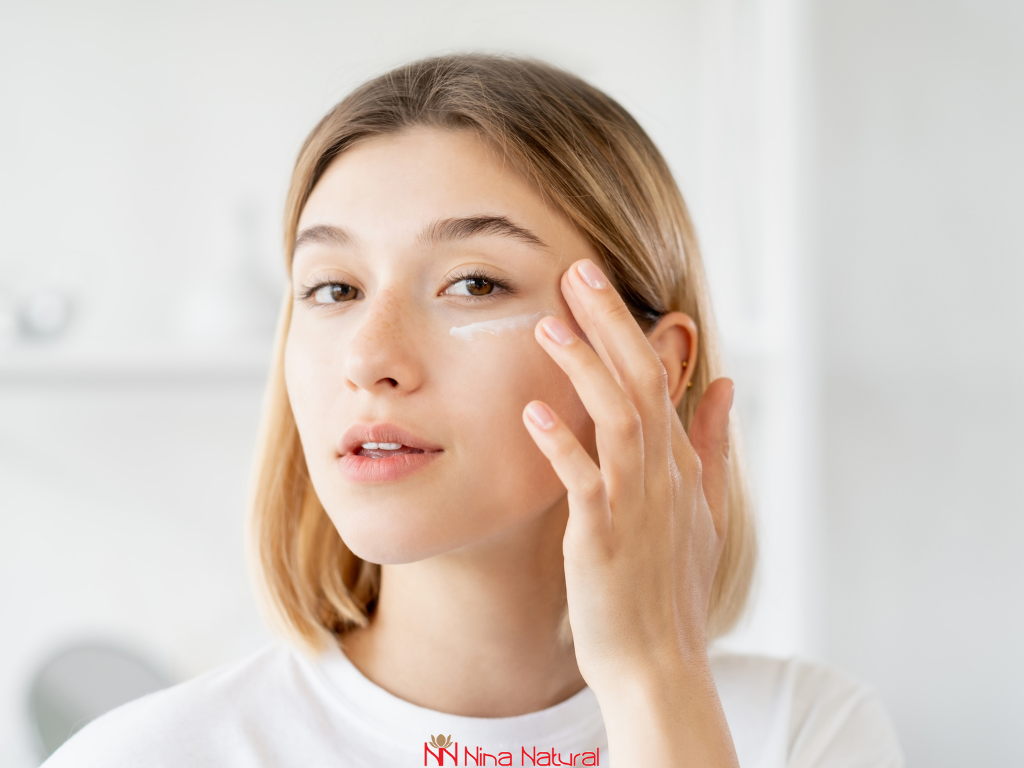
Types of Eye Cream by Skin Type
Young Skin
Ideal formulation:
- Hyaluronic acid (different molecular weights) 1-3%
- Niacinamide 2-5%
- Vitamin C in stable form (MAP or sodium ascorbyl phosphate)
- Gentle peptides (Matrixyl 3000) 3-5%
- Ceramides or squalane for hydration
- SPF 15-30 for daytime variant
Recommended composition:
- 70% hydration
- 20% prevention
- 10% gentle correction
Mature Skin
Ideal formulation:
- Retinyl palmitate or retinol 0.1-0.5%
- Complex of different peptides 5-10%
- Hyaluronic acid + sodium PCA
- Coenzyme Q10 or vitamin E
- Copper peptides 1-2%
- Ceramides + niacinamide
Recommended composition:
- 40% correction of existing wrinkles
- 35% intensive hydration
- 25% prevention of further damage
Sensitive Skin
Ideal formulation:
- Hyaluronic acid in gentle concentration
- Ceramides + cholesterol + fatty acids
- Allantoin or panthenol (vitamin B5)
- Centella asiatica or chamomile extract
- Niacinamide up to 3%
- WITHOUT: fragrances, alcohol, parabens, retinol
Recommended composition:
- 60% soothing and protection
- 30% gentle hydration
- 10% very gentle correction
Dry Skin
Ideal formulation:
- Multiple hyaluronic acid 2-5%
- Glycerin + betaine combination
- Ceramide complex (1, 3, 6)
- Squalane or jojoba oil
- Shea butter or avocado oil
- Urea 3-5% for deep hydration
Recommended composition:
- 70% intensive hydration
- 20% skin barrier restoration
- 10% gentle anti-aging action
Oily Skin
Ideal formulation:
- Niacinamide 5-10% for sebum control
- Light hyaluronic acid
- Zinc PCA or zinc gluconate
- Salicylic acid 0.5% (very gentle)
- Caffeine for reducing puffiness
- Oil-free formula
Recommended composition:
- 50% oil control
- 30% weightless hydration
- 20% wrinkle prevention
Acne-Prone Skin
Ideal formulation:
- Retinyl palmitate (gentler than retinol)
- Niacinamide 3-5% for reducing inflammation
- Salicylic acid 0.5-1%
- Tea tree oil or azelaic acid
- Non-comedogenic moisturizers
- Without mineral oils
Recommended composition:
- 40% inflammation control
- 30% pore clogging prevention
- 30% gentle anti-aging protection
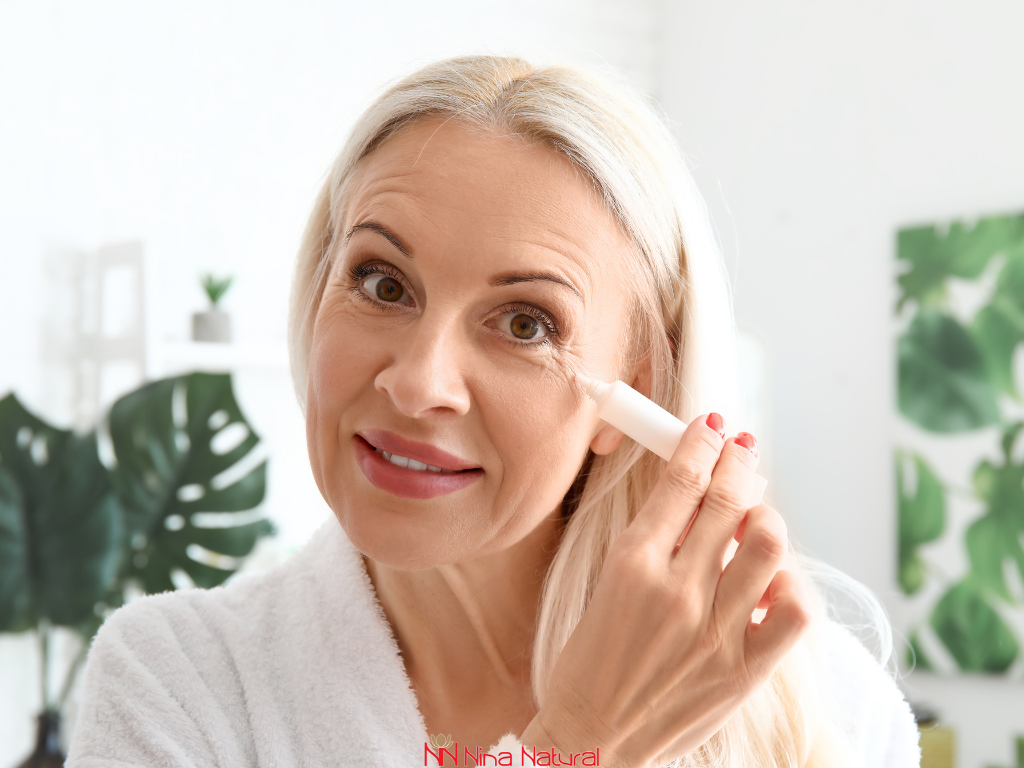
Most Frequently Asked Questions About Eye Creams
“How quickly can I expect results?”
Realistic expectations:
- First 2 weeks: Improved hydration, skin softer to touch
- 4-6 weeks: Fine lines less visible, better skin tone
- 8-12 weeks: Significant reduction in wrinkle depth, firmer skin
- 3-6 months: Visible changes in texture and skin elasticity
- 6+ months: Maintaining results with continued use
Important: Results depend on age, skin type, product quality, and usage routine.
“Can I use eye cream during pregnancy and breastfeeding?”
Safe ingredients:
- Hyaluronic acid
- Vitamin C in stable forms
- Niacinamide
- Ceramides and natural moisturizers
- Caffeine in low concentrations
Ingredients to avoid:
- Retinol and its derivatives
- Salicylic acid in high concentrations
- Certain peptides (consult doctor)
Recommendation: Always consult a doctor before introducing new products into your routine if you’re pregnant.
“What is ‘purging’ and how long does it last?”
Purging is temporary worsening (cleansing) of skin condition when active ingredients accelerate natural cell renewal. With eye creams it’s rarer than with face products.
How it looks:
- Increased sensitivity
- Mild redness
- Dryness or peeling
- Enhanced acne
- Brief burning sensation
How long it lasts: 2-4 weeks for most users When to stop: If symptoms last longer than 6 weeks or worsen
“Can I use multiple eye cream preparations simultaneously?”
Rules for safe combining:
- Different eye cream formulations for day and night
- One active ingredient per product
- Gradual introduction (one weekly)
- Pause if irritation occurs
Best combinations:
- Morning: Eye cream with vitamin C and SPF
- Evening: Eye cream with peptides or retinol derivatives
“Why doesn’t my eye cream show results?”
Common reasons:
- Inconsistent use – Eye cream requires minimum 6-8 weeks of regular use
- Wrong amount – Too little product won’t give results
- Poor product quality – Low concentrations of quality ingredients
- Inappropriate formulation – Product doesn’t suit your skin type
- Unrealistic expectations – Expecting dramatic changes in a month
“Does more expensive eye cream mean better results?”
Not necessarily. Price can reflect:
- Luxury packaging
- Marketing costs
- Brand
- Rare components (which aren’t always necessary)
What to pay attention to:
- Concentration of active ingredients
- Scientific support for formulations
- Reviews from real users
- Compatibility with your skin type
“Can I use eye cream if I wear contact lenses?”
Yes, with caution:
- Choose products that are ophthalmologically tested
- Avoid eye creams with fragrances
- Don’t apply eye cream close to the eye
- Wait for skin to absorb eye cream before putting in lenses or put them in before applying eye cream
“Can eye cream cause allergies?”
They can, especially with sensitive skin.
Most common allergens in eye creams:
- Fragrances and perfumes
- Retinol
- Certain peptides
- Vitamin E in high concentrations
- Lanolin and its derivatives
How to test:
- Patch test on inner wrist
- Wait 24-48 hours
- Start with small amounts
“How long can I use the same eye cream?”
No time limit for quality formulations, but:
Reasons to change:
- Change in skin needs with age
- Appearance of better formulations on market
- Seasonal requirements (summer vs winter)
How to know it’s time to change:
- Results haven’t improved for months
- New problems have appeared (dark circles, puffiness)
- Skin requires stronger or gentler ingredients
“Can I apply eye cream over makeup?”
Generally no, because:
- Won’t absorb through makeup
- Can ruin existing makeup
- Active ingredients won’t reach skin
Conclusion
The skin around the eyes is the most delicate area of our face – first to show fatigue, stress, years, but also first to show results of good care. Eye cream isn’t a luxury but a necessity for every woman who wants to preserve a youthful appearance.
Tips:
- Start on time – Prevention is easier than correction
- Be consistent – Results come with regular use
- Listen to your skin – It will tell you what suits it
- Invest wisely – Quality is more important than brand
- Be patient – Real changes take 3-6 months
Remember: It doesn’t matter how old you are when you start using eye cream – what matters is that you started.

